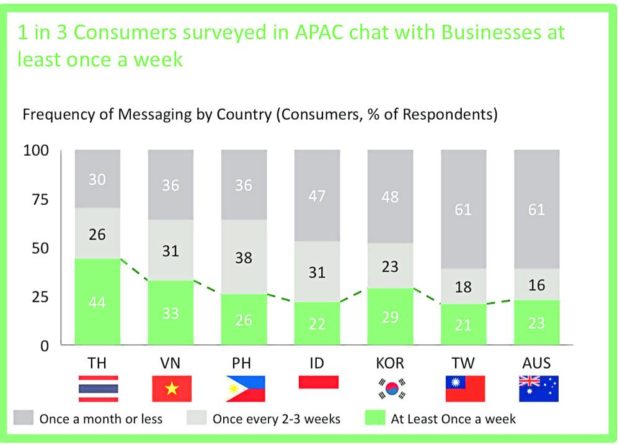Messaging apps now a must for businesses, big or small

Source: Meta and BCG study
Allan Jeffrey “AJ” Bacar, a 28-year-old independent comic artist popularly known as Sskait on social media, has ventured into selling merchandise featuring his artwork as a way to connect with his audience even more.
Around 2019, he set up an online shop to sell comic books, stickers, keychains, mugs and shirts. His fans requested him to do so, and AJ obliged as he saw this as “a way of giving back to the community” that has been supporting his artistic endeavor.
Now, AJ finds himself talking directly to his supporters who send messages to his online shop, inquiring about the product offering and shipping, among others.
In a day, he receives messages from up to 15 individuals and the number goes up to 40 when he launches new products or during “mega sale” days. AJ, as such, hired a part-time employee to help him respond to customer queries.
Article continues after this advertisementWhile doing so is added work, the young entrepreneur says this helps him attract more sales. AJ points out that potential customers can decide better on their purchases if given more information.
Article continues after this advertisementAJ is among those entrepreneurs who find value in answering customer inquiries via chats.
Business messaging is a strategy employed both by small and big enterprises in order to improve customer satisfaction and sales generation, according to a study by Meta and Boston Consulting Group (BCG) titled “Business Messaging: The Quiet Channel Revolution Across Tech.”
Meta Philippines country director John Rubio explains that businesses are expected to have a more “personal” approach when it comes to connecting with their customers via chats.
“So in the same way we interact with friends, family and colleagues, people are now expecting businesses to follow along and change the way they communicate as well,” he says.
Such moves have benefited enterprises as a “lot of them are seeing gains in customer satisfaction, things like agency efficiency, and particularly, improvements in marketing and sales.”
With this, 97 percent of businesses recognize that “messaging apps are important for success.” In fact, seven in 10 large enterprises deem business messaging as crucial to their business model.
Rubio, for example, says that business messaging allows businesses to set up automated responses to typical customer inquiries, making the transactions more efficient on the side of the customers as well. This also allows agents to respond to more complex questions from consumers that require more attention.
Among the sectors with high chatting frequency include beauty products, electronics, apparel, financial services, automotive, furniture and food and beverage.
Interaction with customers
Anthony Oundijian, BCG Manila managing director and senior partner, explains that business messaging is being used for customer inquiry, feedback and consultative support, among others.
About 69 percent of the businesses surveyed claim they use messaging to process orders and transactions. More than half of the enterprises use business messaging for after-sales services as well.
The joint study shows that about 40 percent of the respondents in the Philippines chat with businesses more frequently. Three in five Filipino consumers reach out to businesses at least once every two to three weeks.
Meta and BCG observe this across all age groups, with millennials and Gen Zs having the most interactions with businesses in a month at 8.8 times and 7.2 times, respectively.
“The COVID-19 pandemic forced countries around the world to go into lockdowns, enforce strict social distancing rules and restrict in-person business operations. This resulted in more Filipinos going online, with businesses across many industries increasing their investment and engagement on online channels to connect with customers,” Oundijian explains.
For the study, Meta and BCG surveyed over 6,500 respondents across seven Asia-Pacific countries, including the Philippines.
Oundijian explains that 65 percent of consumers prefer business messaging over email and phone calls.
“There are just many dimensions behind that. There is the convenience of doing this [business messaging] quietly,” he says.
Businesses in the Philippines, the study reveals, choose to make messaging transactions via Meta platforms, including Facebook and Instagram.
Meta, operator of Facebook, notes that 1 billion of its users message businesses each week.
Tips for businesses
The study stresses the importance of having “clear objectives” when it comes to business messaging.
Businesses must evaluate the potential of messaging throughout the whole customer journey and see where it can help solve unique pain points in each phase depending on business context and challenges. The most common problems include delayed or generic responses and no responses after office hours. Consumers are also concerned about businesses that fail to follow up after chatting.
The report points out that “customers want to hear from businesses when the information is timely, personal and relevant.”
As such, Meta and BCG suggest using third-party messaging technology solutions to handle customer interactions.
“This can result in higher chat conversion rates and ability to handle large volumes of enquiries,” the study concludes.
Moving forward, Rubio says that business messaging is set to become the basic standard operating procedures for enterprises, which is in line with consumer expectation.
“As business messaging largely takes place across social and messaging platforms, we are committed to enabling businesses of all sizes with capabilities to activate this channel for growth.”